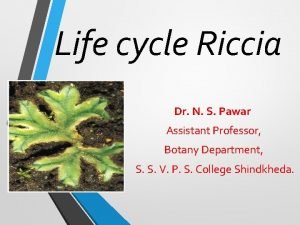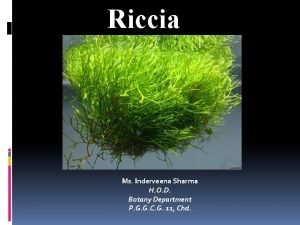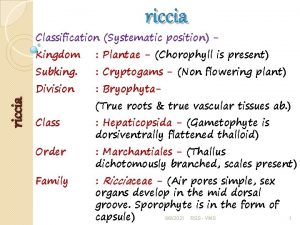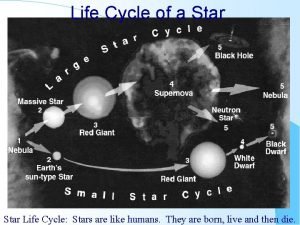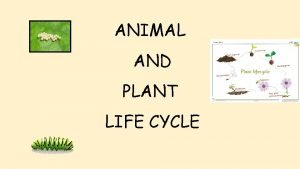Life cycle Riccia Dr N S Pawar Assistant




















- Slides: 20

Life cycle Riccia Dr. N. S. Pawar Assistant Professor, Botany Department, S. S. V. P. S. College Shindkheda.

Systematic Position Division : Bryophyta: Non vascular plants Class : Hepaticopsida: Thallus Heterogenous Order : Marchantiales : Presence of Air Pores Family : Ricciaceae : Ses organs are inside thallus Genus : Riccia

OCCURENCE - The genus was named after an Italian botanist F. F. Ricci - The common Indian species are : R. discolor, R. gangetica, R. frostii, R. melanospora, R. crystallina, R. fluitans All the species grow as terrestrial plants on damp soils except Riccia fluitans which grows in water

GAMETOPHYTIC GENERATION

GAMETOPHYTIC PLANT BODY • thalloid body • small, flat, dorsiventral • dichotomously branched • dorsal surface shows prominent midrib • growing point is situated in the apical notch • ventral surface shows the presence of a large number of rhizoids

Scales and Rhizoids Two types of rhizoids: • Smooth walled : smooth inner walls, living cells, main function is absorption • Tuberculate : peg like projections in inner wall, devoid of protoplasm, main function is mechanical support Scales: • present on the ventral surface of thallus • simple and ligulate type • help to protect the growing point • each scale is simple, multicellular and one cell in thickness

INTERNAL STRUCTURE Photosynthetic Zone : 1) consists of compactly arranged vertical rows of chlorenchymatous cells (assimilatory filaments) separated by narrow vertical air chambers. 2) cells possess chloroplasts and perform photosynthesis. Storage zone : 1) consists of compact, colourless parenchymatous tissue without intercellular spaces. 2) cells contain abundant starch grains. 3) few cells of lower epidermis elongate to produce rhizoids.

REPRODUCTION • Vegetative Reproduction : 1) Fragmentation 2) Formation of adventitious branches 3) Persistent growing apices 4) Formation of tubers • Sexual Reproduction : - oogamous - male sex organs are antheridia (borne in antheridial chambers)and archegonia (borne in antheridial chambers) female sex organs are - some of the species are monoecious and some are dioecious - sex organs arise singly in acropetal succession (youngest at the apex and oldest at the base)

STRUCTURE OF ANTHERIDIUM • differentiated into two parts : stalk and body of antheridium • body of antheridium consists of single layered jacket enclosing a mass of androcytes • each androcyte differentiates to produce single biflagellated antherozoid


DEHISCENCE OF ANTHERIDIUM • • At maturity, the pore of antheridial chamber becomes wide open antherozoids float in a viscous fluid formed by dissolution of cell walls of androcytes sterile jacket of antheridium imbibes water, become softned and disorganises antherozoids ooze out in mass through an opening antherozoids escape and come to dorsal surface of thallus where they swim in the film of water present on the dorsal surface of thallus due to rain or dew the presence of water is essential for the liberation of antherozoids

STRUCTURE OF ARCHEGONIUM It is a flask shaped structure differentiated into three parts : 1) Stalk. 2) Swollen Venter : Consists of single layered wall. It encloses a venter canal cell and a large naked egg. 3) Long neck : consists of 6 - 9 tiers of cells arranged in six vertical rows,

- occurs in the presence of water provided by rain or dew. - at maturity, the neck canal cells and venter canal cell disintegrates and become mucilaginous. - FERTILIZATION water is needed for dehiscence of antheridia, liberation of antherozoids, opening of archegonial neck, movement of antherozoids to archegonia. the mucilaginous substance, when hydrated, exerts a pressure so that the cover cells spread apart. a passage is created at the opening of archegonial neck through which some of the mucilaginous substance oozes out. antherozoids are attracted chemotactically towards some chemical substances present in mucilage. some of them enter into the neck canal. a single antherozoid which reaches first, fuses with the egg. fusion results in the formation of diploid zygote. the gametophytic phase of the life cycle ends with the formation of zygote.

SPOROPHYTIC GENERATION

ZYGOTE • First cell of sporophytic generation • It is diploid • The zygote is retained inside the venter and starts germinating • It produces diploid sporophytic plant body (i. e. the sporogonium) which is dependent on gametophytic plant body

STRUCTURE OF MATURE SPOROGONIUM • embedded centrally in the tissue of gametophyte plant body • represented only by the capsule (spore sac), foot and seta are absent • consists of mass of spores enclosed within the outer layer of calyptra • the spores are generally attached in tetrads • spores are haploid and are the first cells of sporophytic generation • the calyptra layer is a part of gametophyte • spores are enclosed within the gametophytic thalli untill the thallus dies and decays • after that spores are set free in the soil and dispersed by the wind or rain

SPORE - first cell of gametophytic generation - it consists of a mass of cytoplasm with a small haploid nucleus - spore wall differentiated into outer exine and inner intine - exine is hard, thick and intine is thin, translucent

OF SPORES - There is GERMINATION no resting period - the germination requires presence of light, low temperature and sufficient moisture - The spores absorb moisture and swell - a germ tube emerges out through a germ pore - the dense protoplasm flows through the germ tube to its distal end which cuts a large terminal cell - first rhizoid is formed near the base of tube - the terminal cell divides resulting in the formation of two tiers of four cells each - further growth results in the formation of a young flat thallus

GENERATIONS • Life cycle is diplohaplontic. • Alternation of generations is heteromorphic type since the plant bodies of two generations are morphologically dissimilar.

THANKS
 Riccia life cycle
Riccia life cycle Dr satish pawar
Dr satish pawar Kingdom and division of riccia discolor
Kingdom and division of riccia discolor Structure of mature pollen grain
Structure of mature pollen grain The sign makers assistant
The sign makers assistant Workkeys applied mathematics level 5 answers
Workkeys applied mathematics level 5 answers Juliette southard
Juliette southard Fglair google home
Fglair google home Rop santa cruz
Rop santa cruz Promotion from associate professor to professor
Promotion from associate professor to professor Mia irwan
Mia irwan Cisco sbcs
Cisco sbcs Kpu health care assistant
Kpu health care assistant Reardon commerce
Reardon commerce Cooperative interview questions
Cooperative interview questions Ibm software and support
Ibm software and support Vms4200
Vms4200 Knx topology
Knx topology Cuhk assistant professor salary
Cuhk assistant professor salary Scorer and assistant scorer
Scorer and assistant scorer What is a district commissioner
What is a district commissioner
